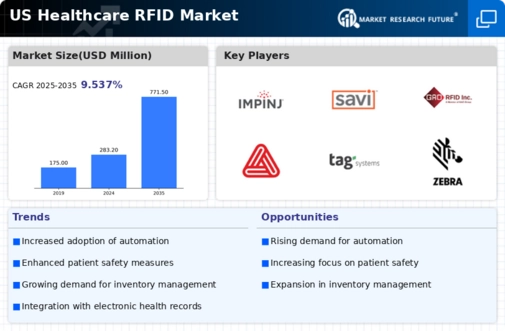Regulatory Compliance and Standards
Regulatory compliance plays a crucial role in shaping the healthcare rfid market. The implementation of stringent regulations regarding patient safety and data security necessitates the adoption of RFID technology. Healthcare organizations are increasingly required to comply with standards set by regulatory bodies, which often include tracking and managing medical devices and pharmaceuticals. This compliance not only ensures patient safety but also enhances operational efficiency. For instance, the FDA has established guidelines that encourage the use of RFID for tracking medical devices, which can significantly reduce the risk of counterfeit products entering the supply chain. As healthcare providers strive to meet these regulatory requirements, the demand for RFID solutions is expected to rise, thereby propelling the growth of the healthcare rfid market.
Increased Focus on Patient Experience
The The market is also influenced by an increased focus on enhancing patient experience.. Healthcare providers are increasingly adopting RFID technology to streamline processes such as patient check-in, medication administration, and tracking patient flow. By utilizing RFID systems, hospitals can reduce wait times and improve the overall patient journey. For example, RFID wristbands can be used to accurately identify patients and ensure they receive the correct treatments, thereby minimizing errors. As patient satisfaction becomes a key performance indicator for healthcare organizations, the demand for RFID solutions that enhance the patient experience is expected to grow. This shift towards patient-centric care is likely to drive further investment in the healthcare rfid market.
Cost Reduction Initiatives in Healthcare
Cost reduction initiatives are significantly impacting the healthcare rfid market as organizations seek to improve their financial performance. With rising healthcare costs, providers are under pressure to find innovative solutions that can help reduce expenses while maintaining high-quality care. RFID technology offers a viable solution by streamlining inventory management, reducing waste, and improving asset utilization. For instance, hospitals that implement RFID systems can potentially save millions of dollars annually by minimizing stockouts and overstock situations. As healthcare organizations continue to prioritize cost efficiency, the adoption of RFID technology is likely to accelerate, further driving the growth of the healthcare rfid market.
Technological Advancements in RFID Systems
The healthcare rfid market is experiencing a surge in technological advancements that enhance the efficiency and accuracy of RFID systems. Innovations such as passive RFID tags, which are cost-effective and require no battery, are becoming increasingly prevalent. These advancements allow for real-time tracking of medical equipment and supplies, thereby reducing operational costs. According to industry estimates, the adoption of RFID technology in healthcare could lead to a reduction in inventory management costs by up to 30%. Furthermore, the integration of advanced data analytics with RFID systems enables healthcare providers to optimize resource allocation, ultimately improving patient care. As technology continues to evolve, the healthcare rfid market is likely to see increased investment in these advanced systems, driving growth and adoption across various healthcare settings.
Growing Demand for Asset Tracking Solutions
The healthcare rfid market is witnessing a growing demand for asset tracking solutions, driven by the need for improved operational efficiency. Hospitals and healthcare facilities are increasingly recognizing the importance of tracking medical equipment, which can lead to significant cost savings and enhanced patient care. Studies indicate that hospitals can lose up to 10% of their assets annually due to misplacement or theft. By implementing RFID technology, healthcare organizations can achieve real-time visibility of their assets, reducing the time spent searching for equipment and minimizing downtime. This trend is likely to continue as healthcare providers seek to optimize their operations and improve patient outcomes, thereby fueling the growth of the healthcare rfid market.





















Leave a Comment